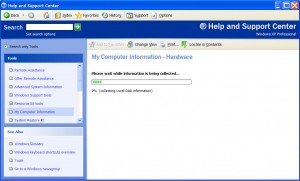by Tina Gasperson
If it’s been a while since you purchased your computer, you may have lost track of what’s in it – how much RAM? How big was that hard drive? What kind of motherboard was that again? And so on. It’s helpful to know what you have in order to diagnose any problems or to upgrade. You’ll need to know what kind of RAM your computer takes, for instance, when you want to replace it or add more. The owner’s manual doesn’t always help, especially when you’ve already upgraded or replaced some parts.
Don’t worry – you don’t have to take your computer apart to find out what kind of hardware you have. From your Windows desktop, click “start,” “Help and Support,” “Tools,” “My Computer Information,” and then “Find information about the hardware installed on this computer.” Windows will take a few moments to collect the information, and then it displays for you in a nice grid layout.
Another way to see information about the hardware installed on your system is to use the Control Panel. Click on “System” and then the “Hardware Tab” and “Device Manager.” This lists all the hardware on your system, and if you double-click on an item you can see information about the device drivers and if the hardware is causing a conflict with anything else in your system. Look at your hardware this way is not as printer-friendly, but it is a good way to troubleshoot device problems.
Tina Gasperson (tinahdee@gmail.com), affectionately known as Computer Lady by her family, has been writing about IT, home computing, and the Internet for more than a decade.
